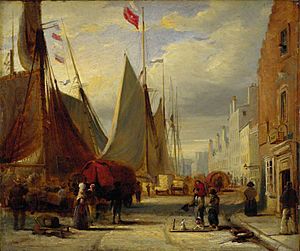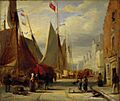Leith Sugar House facts for kids

The first Leith Sugar House was a factory built in 1677 by Robert Douglas and his business partners. Between 1667 and 1701, four sugar refining and rum-making businesses started in Scotland. Three were in Glasgow and one was in Leith. The success of the Leith Sugar House in the 1600s and 1700s shows how Edinburgh was connected to the wider Atlantic economy, which relied on enslaved people's labor.
Contents
Robert Douglas: A Leith Merchant
Starting a Business in Leith
Robert Douglas (who died in 1736) was a successful merchant in Edinburgh. Even though he was a merchant in Edinburgh, he lived and worked mostly in Leith. He was known as a "soap boiler" because he made and sold soap. Some of his soap was made from fish and whale oil. His soap business might have taken over from an earlier one run by Nathaniel Udwart.
In 1666, Robert Douglas sold soap to a wealthy landowner named John Clerk of Penicuik. Clerk's records show he bought different sugar products for his home, including a "Barbados sugar loaf" in 1667.
Why a Sugar House?
Refining sugar, also called "sugar boiling," was a risky business because it could easily cause fires. In 1677, another person in Edinburgh was stopped from boiling sugar in a cellar. This rule helped the Leith Sugar House become the main place for refined sugar in the area.
Finding Investors and Workers
To build and run a sugar house, Robert Douglas needed a lot of money and special equipment. He worked with several partners to help pay for the business. One important partner was Robert Baird of Sauchtonhall. Baird was also involved in a failed colony in Carolina.
Robert Douglas hired a manager named David Forrester to run the sugar business, which was called "The Leith Succar Work Company." They looked for skilled sugar refiners from the Netherlands and England. In 1680, they found a worker from Hamburg who was willing to come to Leith. At first, all the partly refined sugar came from London, but it originally came from the West Indies and Barbados.
Records show that less refined sugar arrived in Leith after the Douglas sugar house opened. This suggests the business was doing well. However, the Leith Sugar House wasn't making rum from molasses (a sugar byproduct) between 1677 and 1683. The sugar houses in Glasgow had already started making rum by 1678.
Sugar from the Caribbean Plantations
Some raw sugar might have come directly to Leith from Barbados and the Leeward Islands. In the 1660s, a ship captain named Edward Burd transported Scottish prisoners from Edinburgh to work in Barbados. He brought sugar and tobacco back to Scotland.
Sugar plantations in the Caribbean were often owned by English people, but some Scottish people worked there too. For example, William McDowall, a Scot, started managing a sugar plantation on Nevis around 1695. This plantation used enslaved laborers. After the Acts of Union 1707, he was able to develop his own plantations.
Other Businesses of Robert Douglas
Robert Douglas was involved in many different businesses. In 1684, he was still called a "soap boiler." He was also appointed a Master of the Hospital at Trinity House of Leith.
In 1695, Robert Douglas, both the elder and younger, invested in the Company of Scotland, which was famous for the Darien scheme. The Scottish Parliament recognized their successful trade with Greenland and Russia, and their plans for making soap, sugar, and even porcelain. They were given special rights to make pottery and distill rum.
In 1703, Douglas asked the Privy Council for official recognition for his "Suggar work at Leith and a sullarie for distilling of Rhum." The Leith sugar house received partly refined sugar from plantations in the Caribbean (where enslaved people were forced to work) through London. They then made loaf sugar, powdered sugar, sugar candy, molasses, and rum.
Douglas also shipped coal to merchants in Hamburg. In 1690, he even processed 23 porpoises that were stranded on the sands at Cramond Island. Robert Douglas the younger also owned a brewery near Leith. In 1709, he had a legal fight about paying taxes on his ale.
In 1720, a Swedish traveler named Henry Kalmeter visited Leith. He described Robert Douglas's soap works. The sugar house next door was then run by Richard Morrow and his partners. Sugar from Barbados was sent to Glasgow and then carted to Leith for refining into sugarloafs and for making rum from sugar syrup. The Douglas family's involvement in the Leith sugar business seemed to end around 1725.
Later Sugar Businesses in Leith
The sugar industry in Leith saw new investments later on. In 1751, the Edinburgh Sugar House Company started, trading with the "sugar colonies of British American Plantations." Another Leith Sugar House opened in 1757 but closed in 1762. Adolphus Happel was also a sugar boiler in Leith in the 1760s.
A "New Edinburgh Sugar Company" started in 1771 but also faced difficulties. It's important to remember that sugar was obtained at a huge human cost due to the use of enslaved labor. Despite this, some historians argue that the sugar industry itself wasn't always very profitable or a major driver for the industrial revolution in Scotland.
In the 1800s, raw sugar continued to arrive from Jamaica to be processed in Leith. Companies like William MacFie and Co. at the Leith Sugar House on Elbe Street and the Leith Sugar Refining Co. on Coburg Street continued the tradition.
Images for kids
-
Leith is a port near Edinburgh where several new industries were sited in the 17th and 18th centuries


